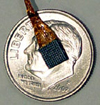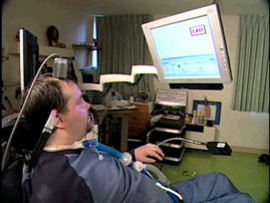

Initially, the range of movement will be limited, but this technology has the potential to tranform the lives of people with spinal cord injuries and who rely on others to feed, wash and dress them.
“They are not going to be writing or piano-playing, but it is a first step to proving a physical connection can be made from the brain to the muscles,” Donoghue said.
Donoghue’s team has had astounding success with a device called BrainGate, an aspirin-sized implant that records electric signals from the part of the brain that processes movement in the limbs. In fact, Matt Nagle, 25 from Massuchusetts learnt in just nine months to use it to move a cursor, open e-mails, play computer games and even operate a single robotic arm.
Donoghue is now researching ways to refine BrainGate’s software to give patients finer control, and of linking it to an existing technology, functional electrical stimulation (FES), that is capable of moving paralyzed muscles.
